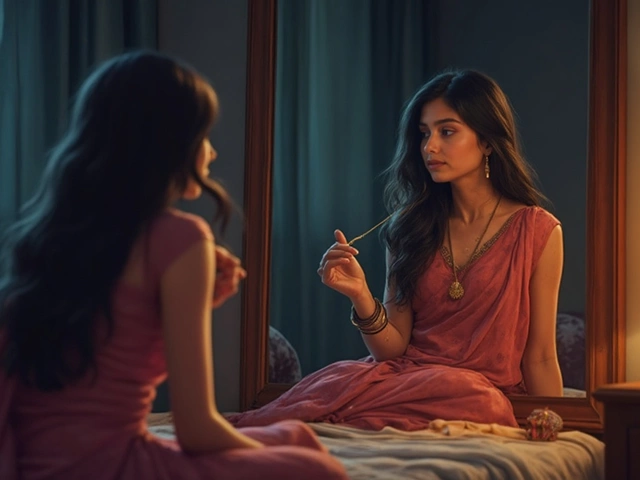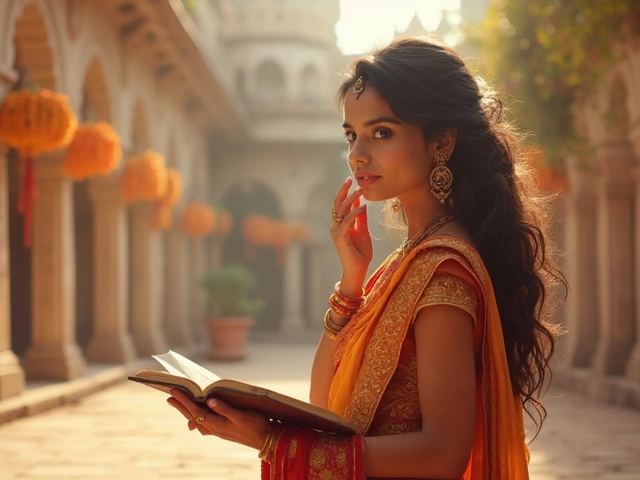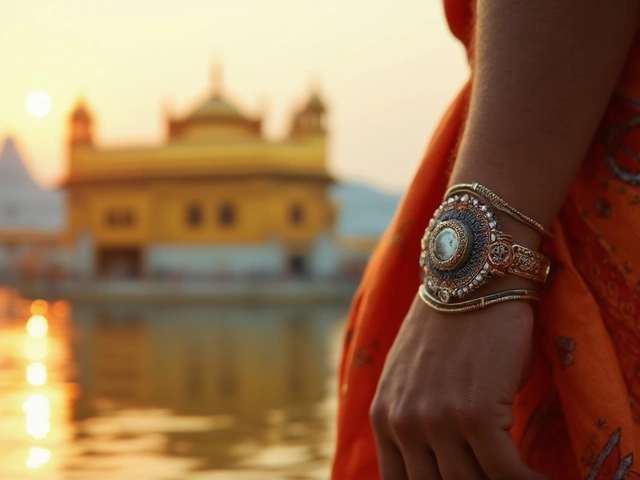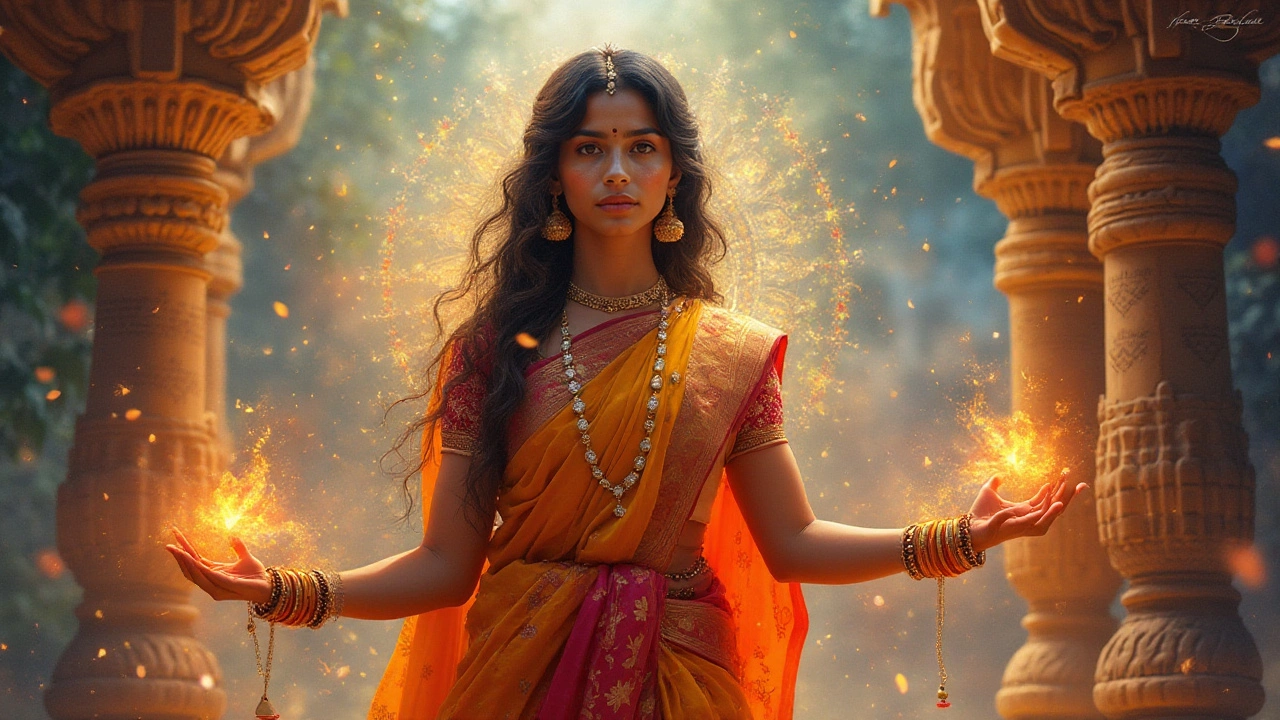
The tradition of wearing bangles is deeply intertwined with the cultural tapestry of India. These circular ornaments are not merely fashion statements; they carry profound symbolism and cultural significance. One of the fascinating questions often asked is, 'Which wrist should you wear a bangle on?' Surprisingly, the answer varies depending on cultural beliefs, astrological insights, and personal preference.
Over centuries, bangles have adorned the wrists of women, carrying stories of age-old rituals and customs. In many Indian communities, bangles are more than decorative; they are powerful symbols of prosperity, emotional balance, and even marital status. As we explore the traditions and beliefs surrounding the wearing of bangles, it becomes clear that this choice is not just about aesthetics but also personal meaning and cultural identity.
- Historical Insights
- Cultural Beliefs and Practices
- Astrological Perspectives
- Fashion Considerations
- Regional Variations
- Practical Tips
Historical Insights
Delving into the history of bangles, we find ourselves journeying back to ancient civilizations where these adornments held far more than decorative value. The earliest known bangles were discovered in the ruins of Mohenjo-Daro, a site that dated back to the Indus Valley Civilization around 2600 BC. Made from materials like shell, copper, and even terracotta, these early bangles were a testament to the artisans' skill and the cultural significance of jewelry even in prehistoric times.
Bangles have featured prominently in the cultural and social lives of many societies. Historians have noted that in ancient India, wearing bangles wasn't just a matter of personal choice but often a societal expectation for married women, symbolizing married status and the well-being of their husbands. The Vedas, ancient Indian scriptures, reference bangles as auspicious symbols that should be worn by women to ensure prosperity and happiness. The importance of these ornaments is vividly illustrated in various art forms such as sculptures and paintings, providing a window into the deep-rooted traditions associated with traditional jewelry.
Sadhguru, a renowned spiritual leader, once remarked, "These bangles, though simple in appearance, carry the legacy of our ancestors, echoing stories untold."
Beyond India, ancient Egyptians also cherished bangles, evident from the decorative pieces found in the tombs of Pharaohs. It is said that Cleopatra herself adored wearing intricately designed bangles that signified her royal status and sophistication. Across cultures, these circular ornaments served as status symbols and were often worn as amulets believed to protect the wearer from evil spirits. As trade routes expanded, so did the distribution of bangles across different regions, leading to diverse styles and materials that reflected local resources and artistry.
The evolution of bangles over the centuries showcases not only changes in fashion but also shifts in cultural interpretations and values. From being purely ornamental items, bangles have become carriers of personal stories and cultural narratives. What remains unchanged, though, is their role as a bridge connecting the past with the present, illustrating humanity's eternal desire for beauty and symbolism through traditional jewelry. As we wear them today, consciously or not, we participate in an age-old tradition that transcends time and speaks volumes of human creativity and spiritual expression.
Cultural Beliefs and Practices
In the vast and diverse landscape of Indian traditions, bangles occupy a significant cultural niche. From the vibrant lanes of Rajasthan to the bustling streets of Kolkata, these ornaments are imbued with stories and beliefs passed down through generations. In Hindu culture, wearing a bangle is not just a fashion statement; it is a deep-rooted practice with spiritual and symbolic importance. The tradition goes beyond aesthetics, intertwining with elements of spirituality and personal well-being. Commonly, it is believed that wearing bangles on the left wrist aligns with the heart's energy, harboring emotions and nurturing the woman's spirit. This practice is often associated with prosperity and health, tapping into centuries-old beliefs about the balance of energies.
The notion of wearing bangles on specific wrists varies across regions and communities. For instance, in some South Indian wedding traditions, brides wear glass bangles on both wrists, but the left wrist is emphasized to signify the heart's closeness and symbolize the emotional bond of marriage. Interestingly, the left side of the body in many cultural beliefs is considered more receptive, and wearing bangles here is thought to attract positive energies and blessings. On the other hand, the right wrist, often associated with action and giving energy, is emphasized in North India during certain festivals, marking a woman's active role in the festivities.
"Bangles have always been more than mere adornments in our culture. They encapsulate emotions, dreams, and the vibrancy of life," notes Dr. Kavita Sharma, a noted historian of Indian art and culture.Traditionally, glass bangles are favored during significant life events. The tinkling sound they make is believed to protect the wearer from negative vibes, acting as a shield against unfavorable spirits. In some regions, the color of the bangle also plays an essential role. Red signifies energy and prosperity, green symbolizes fertility, and yellow stands for happiness. This complex interplay of color, material, and wrist choice highlights how deeply ingrained these practices are in social and religious contexts.
While traditions are revered, modern interpretations of these age-old customs are also emerging. Today, many Indian women opt for precious metal bangles, reflecting a blend of ancient customs with contemporary elegance. Whether as a single metallic hoop or in concert with traditional glass varieties, these choices are often reflections of personal identity within cultural frameworks. As India modernizes, these practices resiliently withstand the test of time, showcasing a culture that values heritage while embracing change. The choice of wrist for wearing a bangle, while steeped in tradition, continues to evolve, illustrating the dynamic nature of culture.
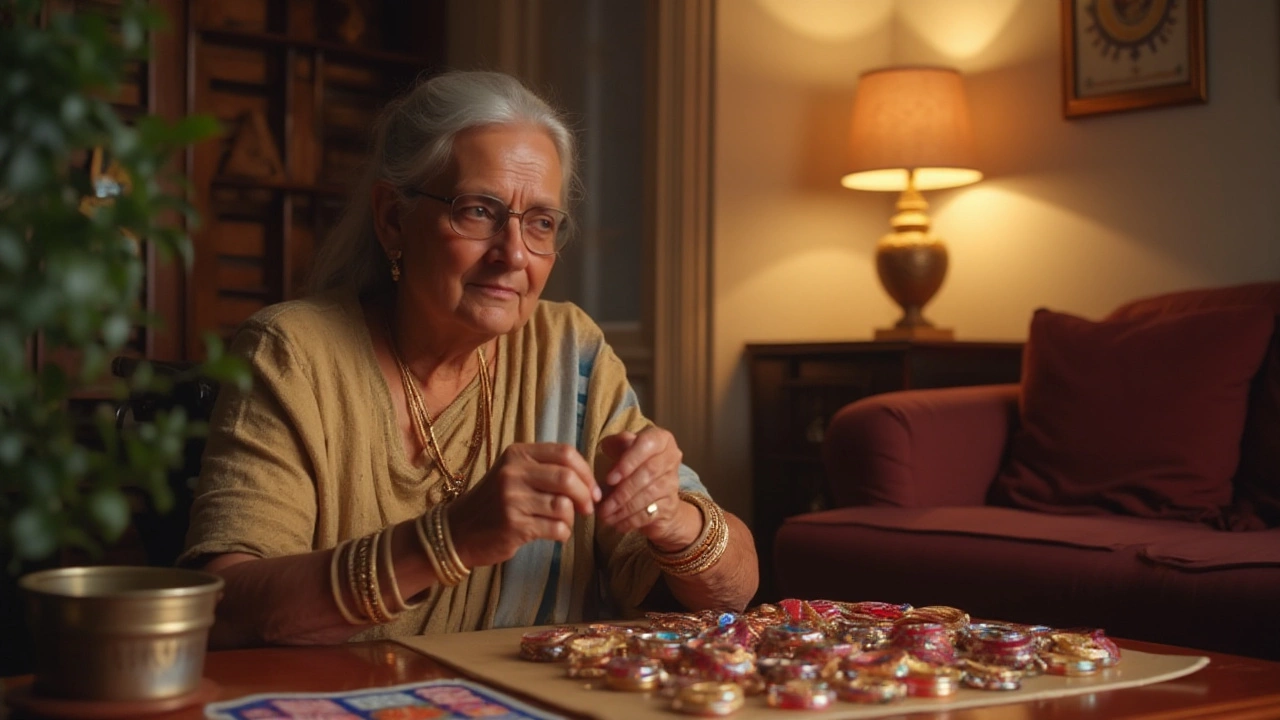
Astrological Perspectives
In the rich tradition of Indian astrology, also known as Jyotish Shastra, the placement of bangles on either the right or left wrist is often guided by the cosmic dance of planets and their influence on human lives. This ancient wisdom suggests that an individual's dominant hand represents different energies and life forces, which can be harmonized using the right adornments. Wearing bangles on specific wrists can tap into these energies, bringing balance and prosperity.
Astrologers often emphasize the significance of the lunar cycle and its phases when considering bangle placement. The Moon, known for its profound impact on emotions and subconscious thought, is closely linked to the left side of the body. Consequently, wearing bangles on the left wrist can enhance one's emotional well-being and intuitive capabilities. It is believed that this practice can also protect the heart by harmonizing emotional energies. Observations suggest that women, in particular, feel more connected to their nurturing instincts when adorning their left wrists.
On the flip side, the right wrist is governed by the Sun, representing strength, ambition, and external expression. In many cultural narratives, adorning the right wrist is seen as a gesture of asserting one's presence and confidence in the outer world. This practice is particularly beneficial for those looking to boost their leadership qualities or facing challenges that require action and assertiveness. Surprisingly, many follow this tradition unknowingly, experiencing a surge of self-confidence and drive in their professional lives.
"Bangles are more than decorative pieces; they are conduits of power that align one's inner and outer worlds," comments Dr. Manisha Sharma, a renowned Vedic astrologer. "Choosing the right wrist to adorn can significantly influence one’s energies and align them with personal goals."
Some astrologers tell their clients to pick certain metals or gemstones for their bangles to get personalized results. For example, gold bangles are said to boost one's status and warmth, while silver enhances intuition and sensitivity. This intricate approach often involves detailed readings of an individual's birth chart, considering planetary positions and zodiac influences to suggest the best wrist and bangle composition.
For those interested in delving further into the mystical alignment of stars and gems, workshops and consultations have become increasingly popular. These sessions explore how bangle choices, grounded in time-tested astrological principles, can subtly influence one's daily life. In an era where ancient practices are finding new resonance, adorning one's wrist with traditional jewelry finds its place as both a personal and cosmic choice.
Fashion Considerations
In the kaleidoscope of fashion, bangles hold a mesmerizing allure that transcends mere adornment. When it comes to incorporating these traditional pieces into contemporary style, there is a delightful dance between cultural reverence and personal expression. While many fashion enthusiasts might ponder the seemingly simple choice of which wrist to adorn, the decision is often steeped in both aesthetic sensibility and outfit coordination. The art of bangle-wearing is as much about fashion as it is about tradition, a dynamic interplay that breathes life into each ensemble.
Choosing the right wrist for traditional jewelry like bangles can redefine an outfit's entire look. Fashion experts suggest considering your dominant hand; by wearing bangles on the non-dominant wrist, one achieves a balanced appearance and avoids any practical inconvenience. On a full moon night, even the moon seems to whisper style secrets to those adorning bangles, echoing thoughts from fashion icon Coco Chanel, who once mused,
'Fashion is not something that exists in dresses only; fashion is in the sky, in the street, fashion has to do with ideas, the way we live, what is happening.'
The right wrist can serve as a captivating canvas where traditional jewelry meets modern elegance. Vibrant stacks of bangles can accentuate a simple outfit, while a single statement piece might echo sophistication in a more understated setting. Color coordination and material choice are key — opting for complementing shades to resonate with your attire can create a cohesive look. Meanwhile, contrasting textures can add an exciting dimension, where the gleam of a gold bangle plays beautifully against the muted tones of silk or linen clothing.
Consider also the fusion of modern and traditional styles: bangles paired with a Western-inspired casual outfit bring a unique cultural depth to fashion. This crossover not only allows for diversity in appearance but also opens a dialogue about cultural appreciation versus appropriation, a topic of relevance in today's fashion discourse. Trends may fluctuate, but the essence of Indian culture embedded in these pieces remains timeless.
Practical fashionistas often ponder how many bangles create the perfect clink without overburdening the wrist. A succinct guideline is to layer them generously during festive occasions, yet play with one or two during a professional setting. A well-curated collection allows for adaptability, where each piece can be front and center or nestled into an ensemble, highlighting personal style preferences.
It's fascinating to see how in a digitalized world, such analog artisan pieces blend effortlessly with modern technology's sleekness. This harmony between old-world craftsmanship and new-world style epitomizes the ever-evolving nature of fashion.
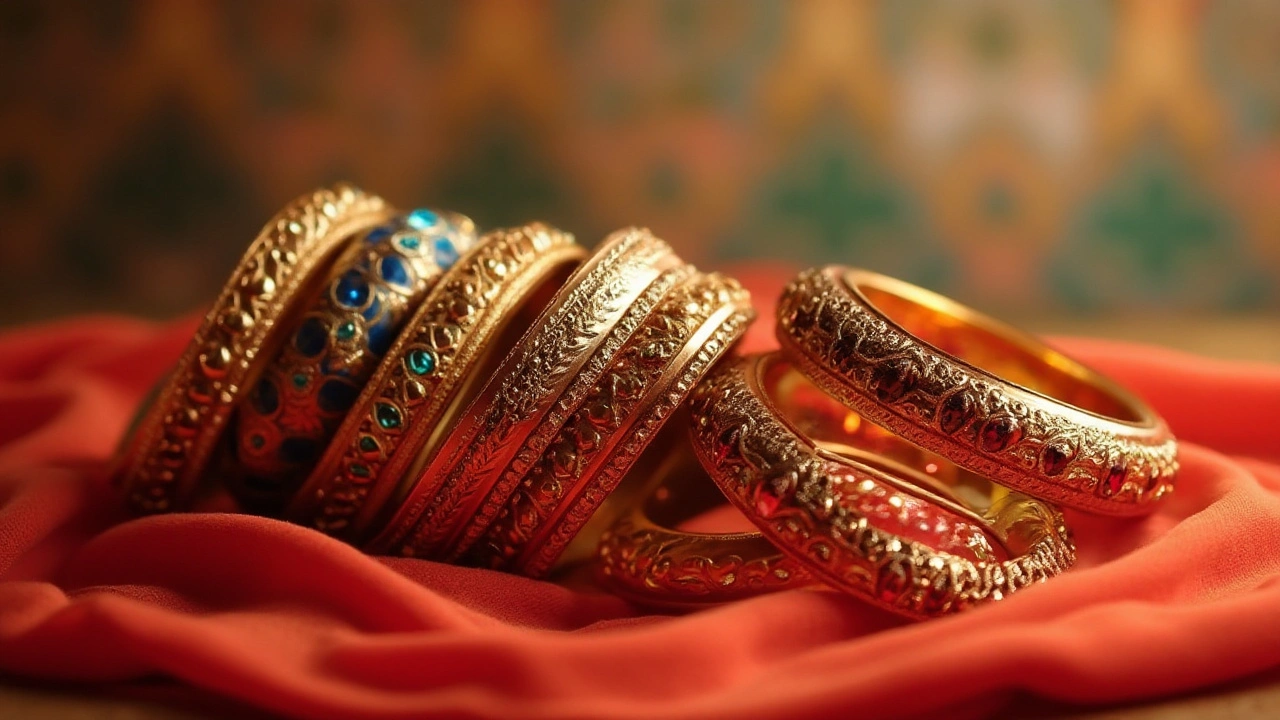
Regional Variations
The diversity of India is richly reflected in its traditional attire, and bangles are no exception. Across the vast Indian landscape, the way bangles are worn can vary significantly, telling unique cultural stories and reflecting the local ethos of each region. In North India, for example, Punjabi brides traditionally wear red and white bangles called chooda, which are believed to bring good fortune and prosperity in married life. These bangles are often worn on the left wrist and sometimes accompanied by small gold ornaments called kalire.
Moving to the western part of India, in the vibrant state of Gujarat, bangles play an integral part in the traditional Garba dance, especially during Navratri. Women wear colorful glass bangles on both wrists, which jingle melodiously as they twirl around in rhythmic abandon. Each color is symbolic, with green representing fertility and prosperity, while red signifies energy and passion. What's fascinating is that during the Garba, it’s common to see an emphasis on matching the bangles with the traditional outfit called Chaniya Choli.
In the East, particularly in Bengal, gold bangles are considered auspicious, with many women choosing to wear them throughout their lives. Historical references indicate that wearing these glowing circle ornaments is not merely a statement of wealth but also an embodiment of continuity and protection. A popular bangle tradition here is the ‘Shakha Pola,’ which are red and white bangles made of conch shell and red coral, respectively, often worn post-marriage. The Bengali bride adorns these on her left wrist, illustrating a journey into a new phase of life.
South India's bangle traditions embrace simplicity yet striking elegance. In Tamil Nadu, it's customary for brides to wear glass bangles layered over gold ones, symbolizing the harmony between wealth and domestic happiness. During traditional functions, women wear bangles in a layered pattern, often following the vivid Indian color palette. In Kerala, though, gold bangles are predominant, representing social status and familial prosperity in a more understated fashion.
The Influence of Local Festivals on Bangle Traditions
What also enhances the bangle tradition across regions is the influence of local festivals. The diversity in festival customs leads to variations in the types of bangles worn, emphasizing culture and regional pride. During Diwali in Maharashtra, for instance, women often choose to wear bangles that shine and glitter, mirroring the festive fireworks. These bangles play a symbolic role, emphasizing brightness and joy, reflecting the triumph of light over darkness.
"In India, bangles are more than a mere accessory; they are a symbol of tradition deeply woven into the social and cultural fabrics." — Mira Gulati, Indian Jewelry Historian.
Such is the charm of bangles in India that they are not only fashion statements but also keepsakes carrying generations' worth of beliefs and artistry. Every bangle worn tells a story, each color chosen narrates an emotion, and every region adds its unique chapter to the rich saga of Indian bangle traditions. These regional variations define the beauty of Indian culture, revealing how a simple ornament can carry profound significance from one wrist to another.
Practical Tips for Wearing Bangles
When it comes to wearing bangles, practicality merges with tradition, creating a harmonious blend that is both stylish and symbolic. The question of which wrist to wear your bangles on often comes down to personal comfort and convenience. To ensure your bangle-wearing experience is as delightful as it is meaningful, here are some practical tips to consider. Firstly, the choice of wrist is frequently influenced by your dominant hand. If you are right-handed, wearing bangles on the left wrist might prevent interference with daily activities. Alternatively, if you seek to emphasize your traditional jewelry during occasions or social gatherings, wearing them on the dominant hand can be a favorable option, attracting more attention and showcasing their beauty to those around you.
Another aspect to consider is the type of bangle and its fit. The size and style of the bangle can significantly impact comfort levels. Snug bangles may become uncomfortable during extended wear, especially if you engage in activities requiring extensive wrist movement. To mitigate this, many prefer adjustable bangles or those with clasps. A touch of personalization, such as choosing bangles adorned with intricate designs or embedded with precious stones, can enhance their aesthetic appeal, making them a reflection of your unique style. Additionally, rotating your bangle selection regularly as part of your jewelry routine ensures longevity and preserves their charm.
It's also essential to incorporate cultural beliefs into your decision. In many cultures across India, wearing a certain type of bangle on a specific wrist holds deep spiritual significance. For instance, glass bangles are traditional carriers of positive energy, their lilting melody often associated with festive joy and prosperity. In some instances, red or green glass bangles are chosen during celebrations, believed to imbue wearers with good fortune. To balance tradition and fashion, consider mixing materials—combining gold embellishments with colorful glass for a rich, layered look. Remember, the most important aspect is to feel connected to your choice, ensuring that your bangles are more than accessories; they are cherished symbols of cultural heritage and personal expression.
To showcase just how personal this experience can be, the renowned fashion icon and cultural historian, Dr. Meenal Patel, once said,
"Bangles are not just cyclic adornments; they are the storytelling circles binding our past, present, and aspirations together."Her insights beautifully encapsulate the profound narrative these pieces of traditional jewelry tell. Whether you aim to highlight cultural roots or express individual fashion tastes, wearing bangles is a joyous journey of exploration. Remember, allowing these pieces to enhance your style while staying true to cultural principles enriches not only your appearance but also your spirit.
Lastly, for those eager to keep up with current trends yet remain rooted in tradition, explore fusion styles combining various bangle forms and materials. This can provide versatility and modern flair while paying homage to classic Indian artistry. Balancing the love for Indian culture with contemporary trends, fusion bangles become a bridge between what was and what is yet to come. With an array of combinations at your disposal, these practical tips can help make your bangle choices both meaningful and visually stunning.
